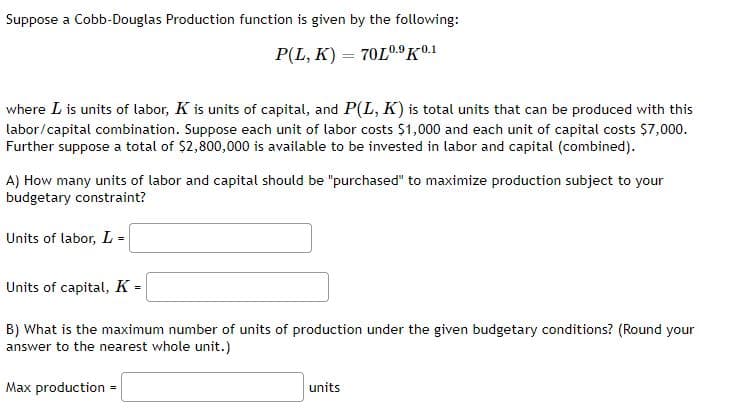Suppose a Cobb-Douglas Production function is given by the following: P(L, K) = 70L0.9K®1 where L is units of labor, K is units of capital, and P(L, K) is total units that can be produced with this labor/capital combination. Suppose each unit of labor costs $1,000 and each unit of capital costs $7,000. Further suppose a total of $2,800,000 is available to be invested in labor and capital (combined). A) How many units of labor and capital should be "purchased" to maximize production subject to your budgetary constraint? Units of labor, L - Units of capital, K - B) What is the maximum number of units of production under the given budgetary conditions? (Round your answer to the nearest whole unit.) Max production units
Suppose a Cobb-Douglas Production function is given by the following: P(L, K) = 70L0.9K®1 where L is units of labor, K is units of capital, and P(L, K) is total units that can be produced with this labor/capital combination. Suppose each unit of labor costs $1,000 and each unit of capital costs $7,000. Further suppose a total of $2,800,000 is available to be invested in labor and capital (combined). A) How many units of labor and capital should be "purchased" to maximize production subject to your budgetary constraint? Units of labor, L - Units of capital, K - B) What is the maximum number of units of production under the given budgetary conditions? (Round your answer to the nearest whole unit.) Max production units
Managerial Economics: Applications, Strategies and Tactics (MindTap Course List)
14th Edition
ISBN:9781305506381
Author:James R. McGuigan, R. Charles Moyer, Frederick H.deB. Harris
Publisher:James R. McGuigan, R. Charles Moyer, Frederick H.deB. Harris
Chapter7: Production Economics
Section: Chapter Questions
Problem 7E
Related questions
Question

Transcribed Image Text:Suppose a Cobb-Douglas Production function is given by the following:
P(L, K) = 70L0.9K01
where L is units of labor, K is units of capital, and P(L, K) is total units that can be produced with this
labor/capital combination. Suppose each unit of labor costs $1,000 and each unit of capital costs $7,000.
Further suppose a total of $2,800,000 is available to be invested in labor and capital (combined).
A) How many units of labor and capital should be "purchased" to maximize production subject to your
budgetary constraint?
Units of labor, L =
Units of capital, K =
B) What is the maximum number of units of production under the given budgetary conditions? (Round your
answer to the nearest whole unit.)
Max production
units
=
Expert Solution
This question has been solved!
Explore an expertly crafted, step-by-step solution for a thorough understanding of key concepts.
This is a popular solution!
Trending now
This is a popular solution!
Step by step
Solved in 3 steps

Knowledge Booster
Learn more about
Need a deep-dive on the concept behind this application? Look no further. Learn more about this topic, economics and related others by exploring similar questions and additional content below.Recommended textbooks for you

Managerial Economics: Applications, Strategies an…
Economics
ISBN:
9781305506381
Author:
James R. McGuigan, R. Charles Moyer, Frederick H.deB. Harris
Publisher:
Cengage Learning



Managerial Economics: Applications, Strategies an…
Economics
ISBN:
9781305506381
Author:
James R. McGuigan, R. Charles Moyer, Frederick H.deB. Harris
Publisher:
Cengage Learning




Microeconomics: Principles & Policy
Economics
ISBN:
9781337794992
Author:
William J. Baumol, Alan S. Blinder, John L. Solow
Publisher:
Cengage Learning
